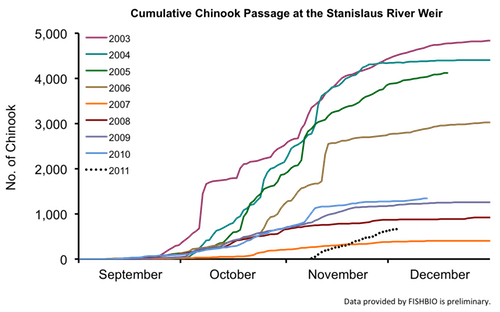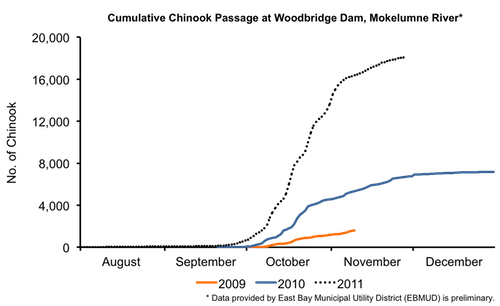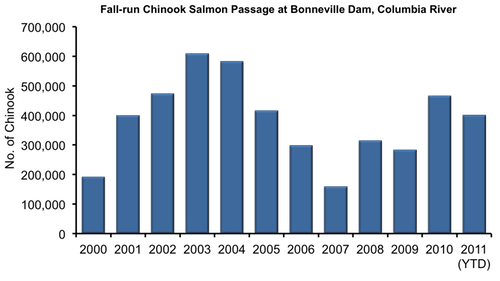San Joaquin River Basin
In the San Joaquin River basin, the Tuolumne River salmon run continues to climb well above the counts recorded in recent years. Passages are recorded by a Vaki Riverwatcher fish counter at the Tuolumne River weir (2,646 as of 12/4/11; Figure 1). The Stanislaus River weir installation was delayed this year due to high flows, but the weir was finally installed on November 8. As of December 4, a total of 682 salmon have been recorded, which is already greater than the entire run (n=408) in 2007 (Figure 2). On the Mokelumne River, passages to-date for 2011, as recorded by video monitoring (18,102 salmon as of 11/29/11), continue to steadily climb (Figure 3).

Figure 1. Daily cumulative Chinook passage at the Tuolumne River Weir, 2009-2011.

Figure 2. Daily cumulative Chinook passage at the Stanislaus River Weir, 2003-2011.

Figure 3. Daily cumulative Chinook passage at Woodbridge Dam on the Mokelumne River, 2009-2011.
Sacramento River Basin
The Battle Creek net passage count of fall-run Chinook has fluctuated since the last update but, due to salmon migrating upstream and down, has remained relatively stable at 24,892 (as of 11/21/11; Figure 4).

Figure 4. Daily cumulative Chinook salmon passage in Battle Creek, 2003-2011.
It has come to our attention that the data previously presented for the year-to-date fall-run Chinook passage on the Yuba River unintentionally misrepresented the passage data available from their website. Data from 2007-2009 was incomplete, and counts during all years may have included individuals from overlapping Chinook runs (i.e., spring, fall and late-fall runs). For more information regarding the Yuba River passage data, please see the annual reports available online at: www.yubaaccordrmt.com.
Russian River Basin
Passages within California's own Russian River continue to rise. As of November 30, salmon counts at the Mirabel Rubber Dam are higher than they have been since 2006 (n=3,084; Figure 5).

Figure 5. Annual fall-run Chinook passage at Mirabel Rubber Dam on the Russian River, 2000-2011.
Columbia River Basin
Further north, at Bonneville Dam on the Columbia River, the fall-run Chinook season has come to an end for 2011. This year, 401,576 Chinook salmon (as of 11/15/11) have been recorded passing the dam, which is consistent with the average for the last ten years (Figure 6).

Figure 6. Annual fall-run salmon passage at Bonneville Dam on the Columbia River, 2000-2011.
Fall-run Chinook salmon counts are definitely moving in a positive direction in 2011, but the increase in marking efforts and observations have demonstrated that a troubling proportion of the run consists of fish that originated from a hatchery. Even low levels of hatchery straying can reduce genetic and life history diversity and jeopardize the viability of the populations (Lindley et al. 2007). The fact that so many salmon in the Central Valley are of hatchery origin is a sign that despite the recent gains, there should still be concern over the future of the Central Valley fall-run Chinook.